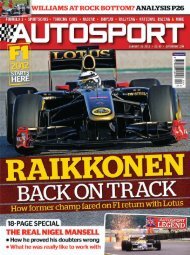final drive - Mundo Motorizado
final drive - Mundo Motorizado
final drive - Mundo Motorizado
Create successful ePaper yourself
Turn your PDF publications into a flip-book with our unique Google optimized e-Paper software.
DRS<br />
DECODED<br />
The problem with F1 aero is you can’t see it.<br />
With the help of AUTOSPORT’s CFD drawings,<br />
GARY ANDERSON and JONATHAN NOBLE<br />
shed some light on the dark art of DRS<br />
Downforce on a Formula 1 car is produced by speed<br />
– so the faster you go, the more downforce you<br />
create. As a car goes from 100km/h to 200km/h<br />
it has four times more downforce.<br />
But there is a limiting factor – and that’s drag.<br />
At speed, the rear wing generates a lot of vortices at the<br />
endplate, which the F1 car effectively has to pull along.<br />
This also creates the ‘dirty’ air that makes overtaking<br />
far more difficult.<br />
The solution to that lack of overtaking action was<br />
the introduction in 2011 of the drag reduction system,<br />
which opens the rear-wing flap in a designated zone<br />
when a car is within 1 second of the one in front.<br />
This is what then happens to the airflow…<br />
FIGURE 1 (CLOSED)<br />
You can see here clearly the vortices coming<br />
off the top corners. There is high pressure<br />
on top of the wing and low pressure<br />
underneath it – and there is also static<br />
pressure. When all three of these forces<br />
meet it creates a rotating movement and<br />
that’s getting pulled along with the car.<br />
FIGURE 2 (OPEN)<br />
The main aim of DRS is to get a reduction<br />
in both downforce and drag. When the<br />
wing is open, you can see how much<br />
smaller the vortex is – which means<br />
the wing is doing a lot less work. The<br />
wing is now much more efficient.<br />
32 autosport.com January 31 2013













